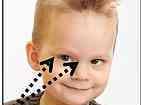This article describes a wearable device for relieving the suffering of thousands of adults and children afflicted with “shaky eye,” also known as “jittery eye” and “dancing eye.” These are shorthand for the medical term,Nystagmus, which is a non-stop, involuntary, rhythmic swaying or twitching of the eyes.
It can be inherited, acquired from a disease or head injury, tumors or toxins, or even an adverse drug reaction. And, depending on the type and severity, this malady can degrade an individual’s quality of life and safety because of reduced vision and depth perception, poor balance and coordination, difficulty reading, denial of a driver license, etc.
There is no cure for most types, so specialists attempt to relieve symptoms through months of eye muscle exercises (Figure 1), surgery, corrective lenses, and medications. Because there are 45 different Nystagmus types, diagnosis and treatment may involve lengthy and costly procedures with limited benefits.
The unique concept proposed herein operates independently for all types of because it uses an electric stimulus to hold the eyeball steady. In brief, when the brain sends an involuntary nerve impulse to eye muscles that then begin a pull to one side, it is detected by sensors, whereupon muscles on the opposite sides of the eyes are stimulated electrically to resist the motion.
A device to serve the stimulus has two main parts, one being a shirt-pocket container for a rechargeable battery, programmable integrated circuit and programmable software, The other being eyeglass frames with electrodes molded into the two nose pieces and two ear pieces.
Special attention must be paid during frame design to assure the electrodes have firm skin contact directly over the muscles on the side of each eye (Figure 2). Standard assembly practices and commercial parts apply to the manufacture of all other circuitry (Figure 3).
In operation, when a neurological impulse from the brain contracts a muscle to pull an eyeball, a voltage change on the skin is detected by a surface electrode and the signature is relayed to the integrated circuit, which analyzes the data for critical parameters. These are compared to Nystagmus parameters in memory collected previously for the individual by a doctor. When there is a match, the integrated circuit applies a voltage to electrodes over muscles on the other side of the eye to stimulate contraction and hold the eye stationary.
R&D is required to identify which parameters in Nystagmus skin voltages are critical, and to design early detection circuity so that stimulation voltages applied to the skin will be low and tolerable for several hours.
The market potential is global, and in the United States alone Nystagmus is reported to annually affect 1 out of every 650 children and 1 out of every 5000 adults. Sales should be assured since the device responds automatically to all 45 types of Nystagmus without costly diagnoses by specialists. Obsolescence is avoided by the ability to reprogram the integrated circuit and update the software and memory on the internet.
Like this entry?
-
About the Entrant
- Name:George Lucey Jr.
- Type of entry:individual
- Patent status:none








